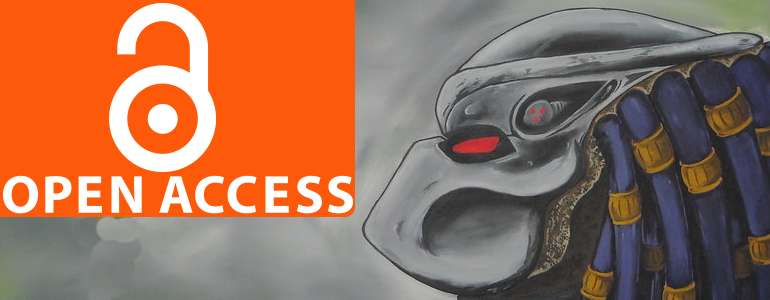
US Gov’t Takes On Predatory Publishers
By Carl Straumsheim| The Federal Trade Commission on Friday filed a complaint against the academic journal publisher OMICS Group and two of its subsidiaries, saying the publisher deceives scholars and misrepresents the editorial rigor of its journals.
The complaint, filed in the U.S. District Court for the District of Nevada, marks the first time the FTC has gone after what are often known as “predatory” publishers. Such publishers exploit open-access publishing as a way to charge steep fees to researchers who believe their work will be printed in legitimate journals, when in fact the journals may publish anyone who pays and lack even a basic peer-review process.
Ioana Rusu, a staff attorney with the FTC, said in an interview that the commission is responding to a growing number of calls from people in academe for some sort of action to be taken against publishers that take advantage of scholars wishing to publish in open-access journals.
“There was definitely a sense that nobody had done anything about it,” Rusu said. “Now we’re watching.”
OMICS’ business practices have been scrutinized for years. The company, based in Hyderabad, India, publishers more than 700 open-access journals, and has created a number of imprints — including iMedPub, also named in the complaint — to expand its presence in the scholarly publishing market. Several of OMICS’ journals have names similar to other, legitimate journals, which critics say is an attempt to confuse scholars.
“If anything is predatory, it’s that publisher,” said Jeffrey Beall, scholarly communications librarian at the University of Colorado at Denver. “It’s the worst of the worst.”
Beall is known for his lists of thousands of “predatory” journals and publishers, and he has for several years written about OMICS and other publishers on his blog. Last month, for example, he published a handful of emails sent to him by researchers caught by surprise by four-digit publication fees or struggling to withdraw their papers from OMICS journals.
Those are the kinds of practices the FTC highlighted in its complaint. OMICS, the commission alleges, does not adequately disclose that authors have to pay a publication fee, falsely claims that its journals are frequently cited and lists academic experts with no connection to the journals as editors.
“As a result, in many instances, consumers only discover that their articles will not be peer reviewed and that they owe fees ranging from several hundred to several thousands of dollars after Defendants inform them that their articles have been approved for publication. Consumers’ attempts to withdraw their articles are frequently rejected, thereby preventing them from publishing in other journals,” the complaint reads. Should the court not take action, it adds, OMICS will continue to “injure consumers, reap unjust enrichment, and harm the public interest.”
The complaint extends to OMICS’ event business, managed through the subsidiary Conference Series. According to the complaint, OMICS regularly advertises conferences featuring academic experts who were never scheduled to appear in order to attract registrants.
OMICS did not respond to a request for comment, but posted a comment to this article this morning denying all charges.
Even if the FTC is successful in its case against OMICS, the commission will only make a dent in the world of “predatory” publishing. One study by researchers at Finland’s Hanken School of Economics found that such publishers flooded the scholarly communications landscape with more than 420,000 articles in 2014, about eight times as many as in 2010.
The FTC does not intend to file thousands of complaints — nor does it have the resources to do so — but Rusu said taking action against OMICS represents the commission announcing its interest in a new field. Typically, the FTC will do so by strategically targeting “some of the most recognized and also some of the worst actors” in that space, she said.
“With a lot of our other areas in which there are bad actors, the best you can hope for is that it’s setting a precedent, … marking a line in the sand and telling people that’s not OK,” Rusu said. “We don’t care if you’re marketing debt collection or publishing.”
Rusu stressed that the FTC is not passing judgment on open-access publishing in general. “We take no sides between the traditional subscription model and the open-access model,” she said. “We believe both of them can be done in a fair, open, clear and lawful way. What we have a problem with here is people who are trying to benefit from the open-access model to scam people.”
The FTC is seeking both monetary relief for researchers that have published with OMICS and to prevent the publisher from further violations of the Federal Trade Commission Act of 1914. Read more

The Acceleration of Open Access
Does it seem like a lot is going on all of a sudden, or am I just old and out of touch? (Don’t answer that.)
I noted with loud applause the launch of SocArXiv just in the nick of time. SSRN had been a for-profit but pretty useful place to store papers in the social sciences, but it was fairly old-school; since it didn’t have the resources to make renovations, it teamed up with Elsevier and that makes it no longer useful for those who think making research findings public should be in the public interest, not in shareholders’ interest. While SocArXiv builds out its infrastructure, it’s got a place where you can put your research and good reasons why you should.
One of the reasons Elsevier acquired SSRN was to branch into supporting scientists’ entire workflow, because that’s where the action will be as the ways we share our research evolve. Well, as it turns out, there’s a non-profit that is already doing exactly this, and it’s playing host to SocArXiv. The Center for Open Science has developed a sweet platform – the Open Science Framework – where scholars can put their stuff, creating an open source infrastructure for researchers’ entire workflow. (Yes, you can! Right now! And librarians, we can explore their institutional option.) Other projects of the Center for Open Science include encouraging reproducibility and finding ways to align practices with principles, such as rewarding openness instead of incentivizing publication of research in places that are not public to most working scientists. It’s all pretty ambitious, but it’s exciting to see that people are thinking big thoughts about how to build new structures and practices that help scientists do their work while living up to their better natures. (And if you’re wondering how we got into this mess in the first place, Kevin Smith has just reviewed Catherine Fisks’ Working Knowledge, which helps explain how corporations altered our concept of copyright, authorship, and intellectual property. Yet another book I haven’t read.)
So we have a Center for Open Science building a fantastic platform for storing and sharing and Cold Springs Harbor with its bioRxiv, and MLA, which has built the MLA Commons for its members with a place to share your research and teaching materials, and now, holy smokes, the American Chemical Society, which not too long ago lobbied against open access to federally funded research, is now looking into creating their own preprint server.
And today I discover the Humanities Commons is coming?!? I feel faint. So much going on. So much positive change in the air.
One fascinating aspect of this is trying to figure out how exactly the culture is changing. Librarians found out with their institutional repositories that building it alone doesn’t make them come. Hard work doesn’t necessarily bring on a cultural shift, either; institutional affiliation has less gravitational pull than disciplines and societies. Even within disciplines, it’s hard for projects like bioRxiv and MLA Commons to attract scholars and scientists who feel the systems they are familiar with are good enough, or that making their work open is too risky or too much work. But with so many projects taking off, and with such robust platforms rolling out to challenge whatever the big corporations will have to offer, I’m feeling pretty optimistic about our capacity to align the public value of scholarship with our daily practices – and optimistic about the willingness of rising scholars to change the system.
I may have trouble keeping up with it all, but that’s okay. It’s moving in the right direction. Source InsideHigherEd

New Open Access Roadmap
New Open Access roadmap sets the goal for a fully open access world
The European University Association (EUA) came up with a new roadmap to assist European universities’ transition towards Open Access (OA). This OA roadmap, which sets the future direction of OA in European universities, is based on the EUA’s expert group agreement on Science 2.0 initiative, the EUA said.
The EUA’s new roadmap primarily focuses on open access to research publications; its prime focus’ areas are open access to research data, copyright, data protection, and text and data mining. The EUA plans to implement its roadmap in consultation with major stakeholders: universities, publishers and funding agencies.
According to the EUA, technological advancements ushered a new era of scholarly publishing, dissemination and consumption, which requires a change in the classical publishing model. The time is ripe for publishers to embrace new realities: publishing or accommodating open access. In this regard, the EUA is determined to facilitate a fair and transparent platform that serves all players.
In its effort to implement the roadmap, the EUA set its priority areas. In the coming twelve months, it has plans to monitor institutional OA policies and map the European Union’s OA landscape. It will also facilitate a platform for institutions’ dialogue, aimed at ‘sharing good practices of “big deal” negotiations’. These ‘big deal’, or bundle, negotiations help universities get better journal subscription fees deals with publishers. With the bundle negotiations, both universities and publishers get a chance to make a good deal: publishers sell their highly demanded journals along with low demanded journals in the same package, for a reasonable price for universities.
Moreover, the association hopes to engage in a dialogue with other pertinent stakeholders in the field. It will also support the development of European OA policies and infrastructures. The implementation of the roadmap, primarily in public universities, requires the support of politicians. That’s why the EUA has put a plan in place to engage politicians for ‘a fair, balanced and innovative publishing system’. This process of engagement might take different forms: seminars, dialogues and symposiums to create awareness of open access.
The EUA’s decision is a big boost for open access. Its roadmap has the potential to accelerate the move towards a fully open access world, while, at the same time, sends an unequivocal message to publishers who still favor the status quo. Moreover, it can be a triggering factor that other university associations (in America, Asia and Africa) will reproduce.

Diamond Open Access
Free to read and free to publish
The primary move towards Open Access is caused by a belief that the results of scientific research are a public good. Therefore, they should be available and accessible to all, regardless of citizens’ ability to pay. Over the years, the Open Access movement has challenged traditional (subscription based) publishers largely through introducing two alternatives: Gold and Green Open Access publishing models. This forced traditional publishers into making changes in their publishing practices.
Gold Open Access faces two challenges. First off, authors or institutions have to pay Article Processing Charges to get their materials published. That means they pay up front to get published materials later ‘for free’. So technically, what they get is not free. Secondly, the articles remain under embargo for a period between six months to one year. Paying for content and not making it accessible to everyone flies right in the face of the Open Access movement.
On the other end of the spectrum lies Green Open Access, which is totally free. There are neither subscription fees nor article processing fees attached to it. Still, there are weaknesses associated with this publishing model. Green Open Access articles are predominantly early pre-print versions of an article, meaning they have not undergone a journal’s rigorous peer review/editorial process yet. This can result in a lack of quality.
Many argue that both Gold and Green models face challenges that pose a threat to the sustainability of Open Access. The third model, Diamond Open Access, attempts to fill the gap left by the Gold and Green Open Access publishing models.
Diamond Open Access, its advocates argue, is an innovative Open Access model which addresses both cost and journal quality concerns. These are critical issues plaguing Open Access journals. For them it is the only model which guarantees the sustainability of open access publishing.
How the new model works
Journal articles published in Diamond Open Access journals have a lot in common with those published in Gold Open Access journals. They both have high quality peer review and editing processes. The principal difference lies in the absence of article processing fees. As mentioned above, the Gold model is made possible by these article processing fees, paid for by authors or institutions. Meanwhile, the Diamond model requires no article processing fees while maintaining journal quality. The emphasis of Diamond OA is on achieving academic goals: making knowledge production, dissemination and consumption as free as possible.
This is realized by volunteers, providing quality editorial and peer review services, who work relentlessly to advance science and to serve the needs of a science-hungry society. These volunteers can be individuals or non-profit organizations who either work for free or fund Diamond Open Access projects. Under the Diamond model both publishing and access to published materials is done free of charge. That means neither authors nor institutions have to pay to publish scholarly materials on Diamond Open Access journals. Moreover, individuals and institutions get access to the published materials for free. In a nutshell, Diamond model hopes to emulate the Wikipedia publishing model.
Incentives for volunteers
Diamond Open Access journals are made possible by batches of volunteers who do editing and reviewing without financial compensation. If this is the case, what are incentives for the potential volunteers? Advocates profess a strong belief that in the absence of financial compensation Diamond Open Access volunteers will still enjoy career benefits, prestige, and recognition from institutions for doing the work. These benefits combined with an earnest motivation to engage in scientific research publication and dissemination will attract plenty of volunteers to do the job.

Open Access vs Predator
Predatory Open Access publishers on the rise
The increase in so-called “predatory” Open Access publishers is posing a threat to the integrity of Open Access publishing. Predatory Open Access publishers charge authors high publishing fees without providing proper editorial and peer review services. They are abusing the opportunity created by the Gold Open Access publishing model which requires authors to pay article processing charges.
Since 2010 the number of predatory Open Access publishers has shown a sharp increase, according to Finland’s Hanken School of Economics. Authors of the research, Cenyu Shen and BO-Christer Bjork, found out that in 2014 alone predatory Open Access publishers had dumped more than 420,000 articles on the market. This shows a nearly 800% increase from the year 2010. The findings of the research are based on a detailed analysis of 613 Open Access journals.
The whole idea behind Open Access publishing is to give people free access to research output for the benefit of science and society. Unfortunately, some Open Access publishers are focused on serving individual or company interests. Their primary motive is to make a profit. Their existence poses a threat to Open Access publishing and the movement. Researchers and authors need to start identifying them.
There are various ways of identifying predatory Open Access publishers. Mr. Jeffrey Beall created a set of criteria for this: editorial quality, publishing standards, integrity and business management. He used these criteria, among many others, to label hundreds of journals as predatory ones. These criteria were used by the researchers to examine the practices of predatory Open Access publishers and also to find out the danger that they are posing to Open Access publishing in general.
Predatory Open Access publishers have developed faster and cheaper publishing models by drastically lowering the quality of their peer review and editing processes. On average they charge authors 178 USD to publish articles within 2 to 3 months from the date of submission. Meanwhile, the average time to publish an article on reputable Open Access journals is 5.9 months.
The research revealed that those predatory publishers mainly prey on authors from Asia and Africa. Nearly 77 percent of the authors exposed to such abuse are researchers from those two regions. India is where the vast majority of predatory publishers are based. This is not surprising at all, as nearly 35 percent of the authors who are abused by the predators are from the same country.
What exposes the authors from these regions to abuse on such a massive scale? Firstly, predatory publishers promise a fast track to publication. This is appealing to many researchers who would like to publish as many papers as possible. Publishing many papers is positively correlated with promotion and greater name recognition. Secondly, their article processing fees are on average far below the industry standard. Both factors are strong incentives for authors from developing regions choose a predatory publisher.
Coupled with the pre-existing concerns over the quality of Open Access journals, the damaging effect predatory publishers might have on Open Access can be far reaching; both in terms of quality and integrity. Shen and Bjork write, “Predatory publishers are causing unfounded negative publicity for Open Access publishing in general.” Perceived lack of quality of Open Access journals is already one of the major reasons mentioned by several authors not to publish on Open Access platforms. Doubtlessly, predatory Open Access publishers are aggravating the negative perceptions of articles published in Open Access, in addition to casting a big shadow over the quality and reputation of Open Access journals and publishers.
Authors can play a significant role in terms of identifying predatory Open Access publishers and denying them the opportunity to prosper. Taking necessary precautions against predatory Open Access publishing serves two purposes: First, it protects authors from the predators. Secondly, authors’ engagement helps protect the quality, integrity and reputation of Open Access publishing.
References:
Scholarly Open Access: Potential, possible, or probable predatory scholarly open-access publishers
Shen C, & Björk BC (2015). ‘Predatory’ open access: a longitudinal study of article volumes and market characteristics.BMC medicine, 13 PMID: 26423063

